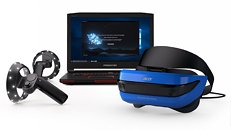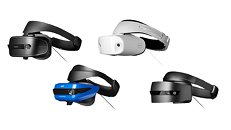Tuesday, August 29th 2017

Microsoft Windows Mixed Reality Push to Include Steam Support, Halo VR
In what is possibly one of the most mouth-watering Microsoft reports as of late for this particular TechPowerUp news editor, it seems that Microsoft is making all the right strides towards bringing its Mixed Reality push to mainstream, popular support. Microsoft seems to have seen the error in its ways towards their usual walled-garden approach, and has announced that their Windows Mixed Reality initiative will see its Mixed/Vitual Reality headsets supporting Steam VR games. This means third-party support for yet another VR hardware piece, and something that Microsoft sorely needed, since adoption of its still upcoming platform wasn't showing much pulse.
But most important than all that (you are allowed to disagree), is that Microsoft is seemingly tapping its first-party studios to produce VR content for its Mixed Reality platform. Case in point, 343 Industries and the Halo franchise. Whether this means VR-only experiences or actual VR-enabled full fledged, numbered Halo games remains to be seen - only Microsoft and 343 know the answer to that. Though it's also likely none of the parts knows much about that at this point in time either; as it seems, and as Microsoft said on their blog post announcing these features, "we are working with 343 Industries to bring future Halo experiences into mixed reality. We are not providing specifics right now, but it is going to be a lot of fun to work with them."Given the nature of Microsoft's push towards Mixed Reality, which places it upon hardware partners to come up with actual products that adhere to Microsoft's standards and adoption requirements, could see a democratization of VR and Mixed Reality for the masses. Even in the wake of Oculus Rift'sand HTC Vive's price-cuts in recent times, Microsoft partners' MR headsets should still come in at lower price-tags, with the added bonus of not needing a room-scale setup for motion tracking due to 6 DoF controllers, unlike the solutions already on the market. Microsoft said that "A variety of Windows Mixed Reality headsets and motion controllers will be available this holiday from HP, Lenovo, Dell, and Acer. Headset and motion controller bundles will start as low as $399 and will be compatible with existing and new PC models starting at $499."Microsoft has also created two separate tiers of PCs for WMR (Windows Mixed Reality) support; for now, all we know is these are only separated by the framerate they can support with any given content. "Windows Mixed Reality PCs" should make use of integrated graphics and be able to handle 60 FPS, whereas "Windows Mixed Reality Ultra PCs" should make use of discrete graphics processing units and deliver 90 FPS.Regarding Steam support, Microsoft said that "Steam content will also run on Windows Mixed Reality headsets. Virtual reality enthusiasts know that Steam is a great place to enjoy cutting edge immersive experiences.", which makes it seem as if Steam VR content will be available on Microsoft headsets, and not just a 3D pop-up of what's being rendered.
Sources:
Blogs @ Microsoft, via Tom's Hardware
But most important than all that (you are allowed to disagree), is that Microsoft is seemingly tapping its first-party studios to produce VR content for its Mixed Reality platform. Case in point, 343 Industries and the Halo franchise. Whether this means VR-only experiences or actual VR-enabled full fledged, numbered Halo games remains to be seen - only Microsoft and 343 know the answer to that. Though it's also likely none of the parts knows much about that at this point in time either; as it seems, and as Microsoft said on their blog post announcing these features, "we are working with 343 Industries to bring future Halo experiences into mixed reality. We are not providing specifics right now, but it is going to be a lot of fun to work with them."Given the nature of Microsoft's push towards Mixed Reality, which places it upon hardware partners to come up with actual products that adhere to Microsoft's standards and adoption requirements, could see a democratization of VR and Mixed Reality for the masses. Even in the wake of Oculus Rift'sand HTC Vive's price-cuts in recent times, Microsoft partners' MR headsets should still come in at lower price-tags, with the added bonus of not needing a room-scale setup for motion tracking due to 6 DoF controllers, unlike the solutions already on the market. Microsoft said that "A variety of Windows Mixed Reality headsets and motion controllers will be available this holiday from HP, Lenovo, Dell, and Acer. Headset and motion controller bundles will start as low as $399 and will be compatible with existing and new PC models starting at $499."Microsoft has also created two separate tiers of PCs for WMR (Windows Mixed Reality) support; for now, all we know is these are only separated by the framerate they can support with any given content. "Windows Mixed Reality PCs" should make use of integrated graphics and be able to handle 60 FPS, whereas "Windows Mixed Reality Ultra PCs" should make use of discrete graphics processing units and deliver 90 FPS.Regarding Steam support, Microsoft said that "Steam content will also run on Windows Mixed Reality headsets. Virtual reality enthusiasts know that Steam is a great place to enjoy cutting edge immersive experiences.", which makes it seem as if Steam VR content will be available on Microsoft headsets, and not just a 3D pop-up of what's being rendered.




9 Comments on Microsoft Windows Mixed Reality Push to Include Steam Support, Halo VR
It's good to see Microsoft getting in on the VR market and lowering prices with some new tech. HTC Vive and Oculus Rift likely will provide a better experience in this generation but next gen may be different.
If it's using any similar tech to HoloLens it should track very well - of all the complaints I've read about that developer unit, motion tracking and head tracking was absolutely not one of them.
This is where HoloLens really shines as you don't have external sensors or a tether and the tracking works very well, however, I find the draw backs to that device to be massive in comparison to any other HMD-- which is a really bad FOV horizontal and veritcal (literally about the size of a deck of cards held 6-8 inches away from your face) and the limited amount of processing power built in only lets you have the most basic of graphic overlays. It's early days though and the HoloLens dev kit has been around a while, which makes the components a little dated at the moment.
this Halo experience Microsoft talks about is going to be so on rails.. Look to the left, Look to the right Chief lol
Microsoft Media Center was IMO the best HTPC software of its kind. After reaching a level of excellence and a dearth of commercial competition it was dropped. Worse, Microsoft actively tried to destroy it. I say this because not supporting Media Center in Windows 10 is one thing but we now know that Media Center would work perfectly well in Windows 10 due to the Media Center Windows 10 initiative.
So what we have is Microsoft actively removing preinstalled software from Windows 7 / 8 systems upgrading to Windows 10 even though there was no legitimate reason to do so.
Microsoft should have allowed systems with Media Center to keep it but simply not support it in Windows 10, not remove it or actively try to disable it.